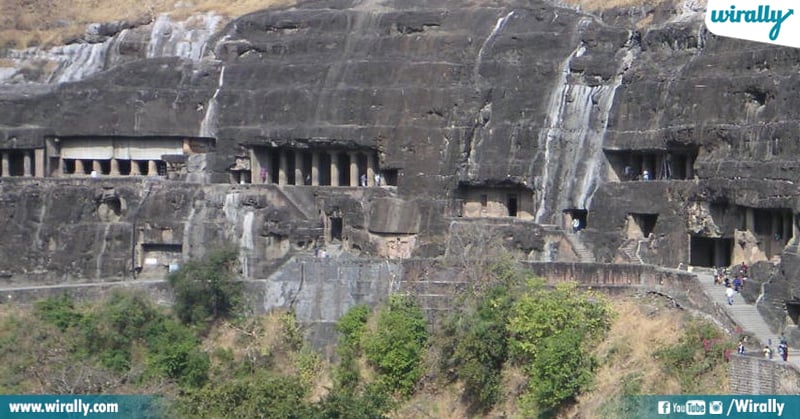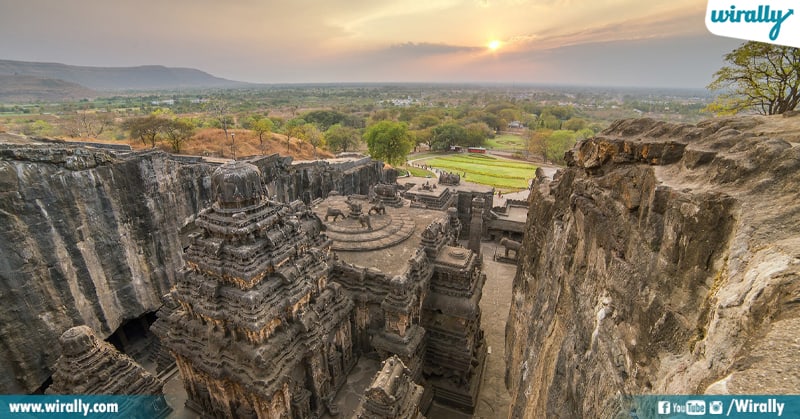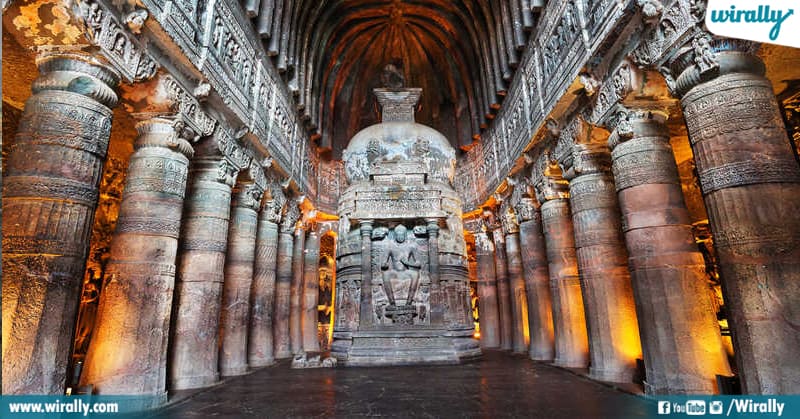- Ajanta Caves are around 30 caverns situated in the Indian province of Maharashtra.

- With Ellora Caves, they are among the most-visited destinations in India.

- Both Ajanta and Ellora are constantly referenced together however they are around 60 miles separated.
- The Ajanta Caves were made an UNESCO World Heritage site in 1983.
- Cut into slope rock, Ajanta and Ellora caverns are frequented by sightseers from everywhere around the world. The 34 caverns at Ellora and 29 caverns at Ajanta were found by John Smith, a British Officer in 1819 incidentally unearthed the pony shoe molded stone while chasing a tiger. The passageway to the cavern-like structures charmed the British authority enough to make them cross the Waghora River in the region and arrive at the caverns. Before long, archeological specialists uncovered the locales and the information on disclosure of these caves spread fire among European voyagers.
- Buddhist priests lived in the valley, from the second century BCE to about the seventh century CE.
- Most of the paintings in the Ajanta cave are towards the life, events and significance of Buddha and Buddhist religion. However Ellora caves contain paintings pertaining to Buddhism, Jainism and Hinduism, it proves the spirit of tolerance that was characteristic of ancient India.
- Numerous Foreigners are incorporated as worshippers going to the Buddha’s drop from Trayastrimsa Heaven. This is proof for the reach of Buddhism as an early influential religion.

- Ajanta caverns are a series of 30 Buddhist caverns. It embraces both Theravada (Hinayana) and Mahayana Buddhist conventions.
- Phase I otherwise called Satavahana has a place within the Hinayana period of buddhism. For an incredible duration Buddha was against sculpting and painting pictures of himself. Consequently, this stage portrays the Lord through images.
- The phase II are a committed by the Vakatakas and Chalukyas and have a place with Mahayana period of Buddhism.The second phase was of more prominent masterful art movement at Ajanta during the standard of the Vakataka administration. Ruler Harishena is credited to have been at the front line of this change of artistic and aesthetic leap.

The stupa is cut with a standing picture of Buddha. This cavern is known for its sculptural magnificence of the exterior part of the caves too. The corridor has painted portrayals of Buddha in different stances. Cave 19 is the first case of a chaitya completely in stone. - Significant distinction from Phase I is the portrayal of Buddha because of the spread of Mahayana Buddhism which trusts in worshipping the Master through pictures and icons.
- Through the art of Ajanta caves have given us knowledge into a period we think minimal about, through these two stories. Through this visual window, we find out about the clothing the kings and elites wore at that point, their overall facial features and their lifestyle in a broader sense.
- The artistic creations at Ajanta are not frescoes but Mural paintings.
- Among the 12 caves of Ellora, just one is a supplication lobby (chaitya griha) while others are monasteries
- Cave 5 is remarkable on the grounds that it is planned as a lobby with two equal refectory seats in the middle with a Buddha sculpture in the back. Cave 5 of Ellora and Cave 11 of the Kanheri caverns are just two such Buddhist places in India.
- The caves were not officially finished as most of the paintings have paint loss. The following painting is of Vidhura Jataka

- Kailashnath Temple [CAVE 16]
- The sanctuary is mostly a Shaivite sanctuary in spite of the fact that figures having a place with Vaishnavism are likewise found here. Credited to Krishna I, a Rashtrakuta ruler, this sanctuary was developed around the center eighth Century AD. This sanctuary is world acclaimed for being the biggest single solid excavation on the planet. The sanctuary engineering shows hints of Pallava and Chalukya styles. This combination is a consequence of the impact of Virupaksha sanctuary of Pattadakal (Chalukyan sanctuary) and Kailasa sanctuary of Kanchi (Pallave sanctuary).
- The sanctuary comprises four sections – the fundamental altar, the passage door, a halfway place of worship for Nandi and mandapa encompassing the patio. This is the main sanctuary where carvers began from the highest point of the stone and unearthed downwards. All other stone developments of the rest of the world are made by cutting the stone or mountain from the front and cutting it as they come. This is a typical method for building any structure from a stone or mountain. It is classified as the “Cut – in” method while Kailasa sanctuary is the main sanctuary which works by utilizing a careful inverse procedure called “Cut-Out”. Archaeologists affirm that it was built in under 18 Years. That implies, back in those years, 400,000 tons of substantial stone was scooped out by utilizing common gear like hammer and cutters and the sanctuary was prepared with carvings only took 18 years to build. An architectural marvel indeed.
- Jain Monuments [CAVE 30-34]
- These caverns have a place with the Digambara faction. The accentuation in the Jain caverns is the portrayal of 24 Jinas. Alongside them yakshas, yakshis and human worshippers are portrayed. The most noteworthy Jain are the Chhota Kailash (cave 30), the Indra Sabha (cave 32) and the Jagannath Sabha (cave 33). Among its reverential carvings, the Jain Ellora caves probably offer the Samavasarana pictures. Samavasarana is of extraordinary interest to Jains, as it is where the Tirthankara lectures in the wake of achieving Kevala Jnana/freeing omniscience.
- The caverns are presently ensured by the Archeological Survey of India.
- The figures and different structures of these caverns are cut out of stone utilizing just a mallet and etch.
- Cavern 15 of Ellora Caves which is known as Dashavatara is mainstream for portraying the ten symbols of Lord Vishnu.
- Towards the finish of the rule of Harisena, these caverns were relinquished and ultimately failed to remember as the centuries progressed. The thick timberlands were halfway to be accused for disguising these caverns.
- Despite the fact that the caverns are more than 2,000 years of age, the Buddha sculptures had been added close 600 years after the fact.
- Masterful style from Srilanka and Tibet are the significant impact. The compositions portray the occurrences from the life of Gautam Buddha and the Jataka Tales.
Also Read: 25 Years For Ammoru: Some Unknown Facts About This Graphical Wonder


















